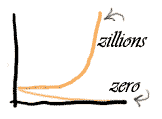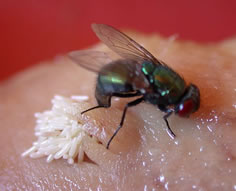Summary of exponential growth
As she paced the floor, and the ceiling, I tried to make sense of it all, but it just didn't add up. From what she had told me, we should either have had more relatives than a Smith family reunion or there should have been none at all, including the Ms. Domestica currently sitting on my wall. |

 So, one way to summarize this is to say that the exponential growth process creates zillions of offspring (or more correctly, an infinite number) for ANY growth rate that's bigger than 1. The zillions are created faster for high growth rates than for low growth rates. And if the growth rate is less than 1, then the population dwindles (again, slowly or rapidly) to zero. So the ultimate outcome is … either zillions or zero. No in between.
So, one way to summarize this is to say that the exponential growth process creates zillions of offspring (or more correctly, an infinite number) for ANY growth rate that's bigger than 1. The zillions are created faster for high growth rates than for low growth rates. And if the growth rate is less than 1, then the population dwindles (again, slowly or rapidly) to zero. So the ultimate outcome is … either zillions or zero. No in between.
Not too interesting. Or too likely. So why study this model?
- It is a simple process that allows you to get your feet wet before jumping into more complicated stuff
- Many organisms behave AS IF their populations are growing exponentially, especially when they have small populations and lots of resources.
I felt for the hard comfort of the fly swatter resting in my holster. What wasn't she telling me? |
Copyright University of Maryland, 2007
You may link to this site for educational purposes.
Please do not copy without permission
requests/questions/feedback email: mathbench@umd.edu